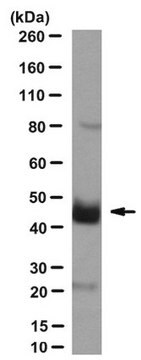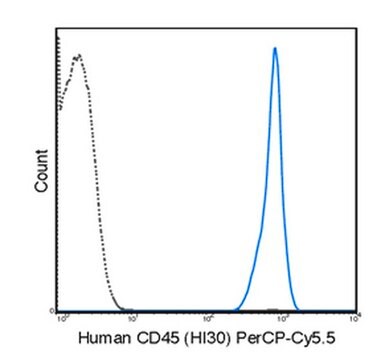MABS1298
Anti-PAR4 Antibody, clone 5F10
clone 5F10, from mouse
Synonym(e):
Proteinase-activated receptor 4, PAR-4, Coagulation factor II receptor-like 3, Thrombin receptor-like 3
About This Item
Empfohlene Produkte
Biologische Quelle
mouse
Qualitätsniveau
Antikörperform
purified immunoglobulin
Antikörper-Produkttyp
primary antibodies
Klon
5F10, monoclonal
Speziesreaktivität
human
Methode(n)
flow cytometry: suitable
immunocytochemistry: suitable
inhibition assay: suitable
western blot: suitable
Isotyp
IgG2bλ
NCBI-Hinterlegungsnummer
UniProt-Hinterlegungsnummer
Posttranslationale Modifikation Target
unmodified
Angaben zum Gen
human ... F2RL3(9002)
Allgemeine Beschreibung
Spezifität
Immunogen
Anwendung
Zelluläre Signaltransduktion
GPCR-, cAMP/cGMP- & kalziumabhängige Signalübertragung
Immunocytochemistry Analysis: A representative lot detected the expression of exogenously transfected human PAR4 by fluorescent immunocytochemistry staining of 4% formaldehyde-fixed HEK293 Flp-In cells following tetracycline treatment (Mumaw, M.M., et al. (2015). Thromb. Res. 135(6):1165-1171).
Flow Cytometry Analysis: A representative lot detected tetracycline-induced expression of exogenously transfected human PAR4 on the surface of HEK293 Flp-In cells. Thrombin treatment diminished cell surface PAR4 immunoreactivity (Mumaw, M.M., et al. (2015). Thromb. Res. 135(6):1165-1171).
Inhibition Analysis: A representative lot, when added prior to thrombin, protected cell surface PAR4 against thrombin cleavage (Mumaw, M.M., et al. (2015). Thromb. Res. 135(6):1165-1171).
Western Blotting Analysis: A representative lot detected MBP fusion proteins containing human PAR4 fragment a.a. 18-78 or 41-66, but not 48-72. MBP-PAR4 fusion degradation by thrombin treatment ablolished target band detection by clone 5F10 (Mumaw, M.M., et al. (2015). Thromb. Res. 135(6):1165-1171).
Western Blotting Analysis: A representative lot detected tetracycline-induced expression of exogenously introduced human PAR4 in a HEK293 Flp-In cell line, as well as endogenous PAR4 in isolated human platelets (hPLTs). Thrombin activation of hPLTs diminished PAR4 target band detection (Mumaw, M.M., et al. (2015). Thromb. Res. 135(6):1165-1171).
Qualität
Western Blotting Analysis: A 1:250 dilution of this antibody detected PAR4 in 50 µg of human platelet lysate.
Zielbeschreibung
Physikalische Form
Lagerung und Haltbarkeit
Sonstige Hinweise
Haftungsausschluss
Sie haben nicht das passende Produkt gefunden?
Probieren Sie unser Produkt-Auswahlhilfe. aus.
Lagerklassenschlüssel
12 - Non Combustible Liquids
WGK
WGK 2
Flammpunkt (°F)
Not applicable
Flammpunkt (°C)
Not applicable
Analysenzertifikate (COA)
Suchen Sie nach Analysenzertifikate (COA), indem Sie die Lot-/Chargennummer des Produkts eingeben. Lot- und Chargennummern sind auf dem Produktetikett hinter den Wörtern ‘Lot’ oder ‘Batch’ (Lot oder Charge) zu finden.
Besitzen Sie dieses Produkt bereits?
In der Dokumentenbibliothek finden Sie die Dokumentation zu den Produkten, die Sie kürzlich erworben haben.
Unser Team von Wissenschaftlern verfügt über Erfahrung in allen Forschungsbereichen einschließlich Life Science, Materialwissenschaften, chemischer Synthese, Chromatographie, Analytik und vielen mehr..
Setzen Sie sich mit dem technischen Dienst in Verbindung.







